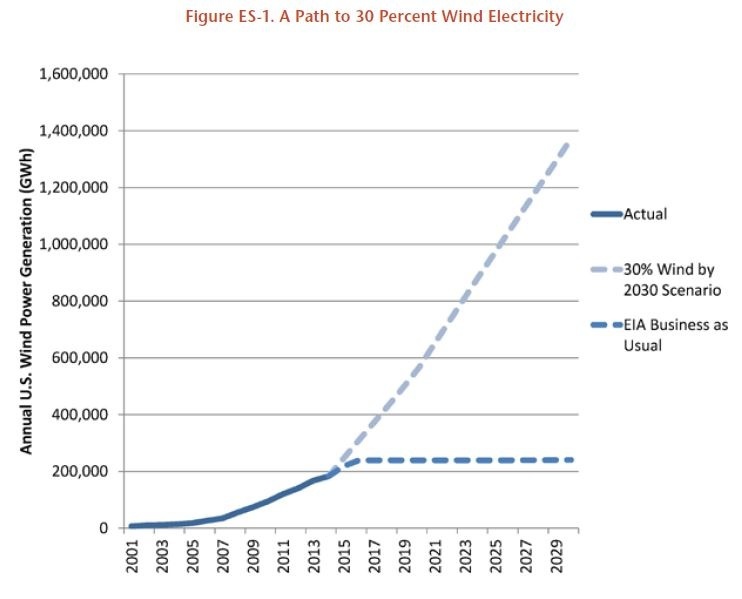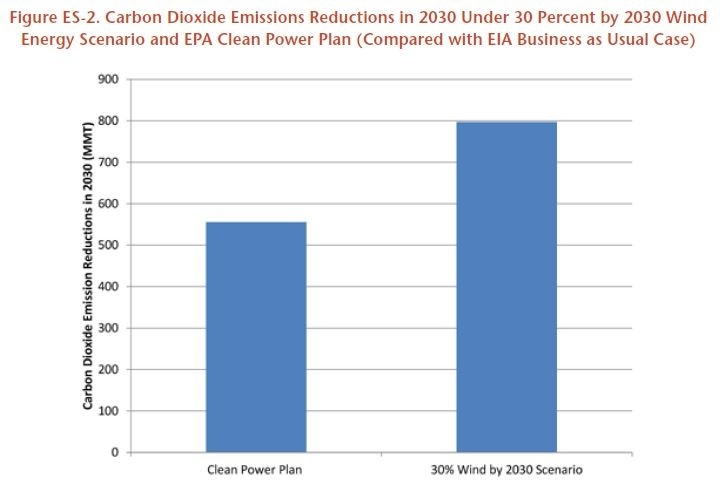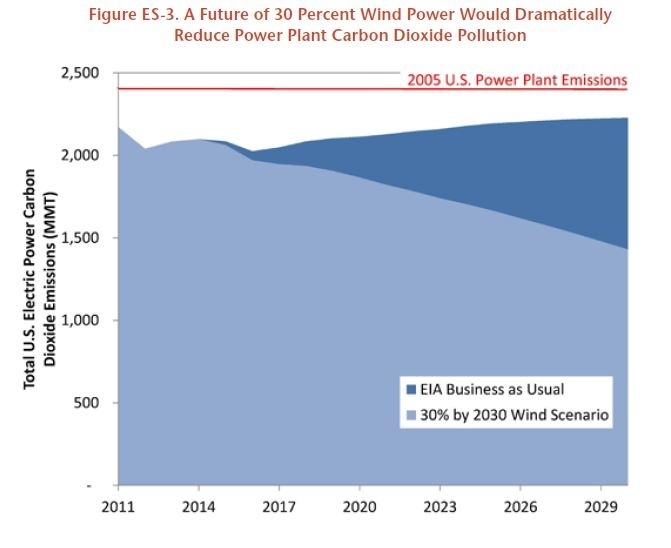Report Excerpt - More Wind, Less Warming
Wind power is on the rise across America. The United States generates 24 times more electricity from wind power than we did in 2001, providing clean, fossil fuel-free energy that helps the nation do its part in the fight against global warming.
American wind power is already significantly reducing global warming pollution. In 2013 alone, wind power averted 132 million metric tons of carbon dioxide emissions – as much as would be produced by 34 typical coal-fired power plants. But with the United States and the world needing to move toward a future of 100 percent clean energy in order to prevent the worst impacts of global warming, America must do much more.
If America were to take advantage of just a fraction of its wind energy potential to get 30 percent of its electricity from the wind by 2030, the nation could cut carbon emissions from power plants to 40 percent below 2005 levels. That much wind power would help states meet and exceed the carbon dioxide emission reductions called for by the Environmental Protection Agency’s draft Clean Power Plan, and help the nation meet its commitment to cut U.S. carbon pollution by 26 to 28 percent by 2025.
Power plants are the biggest source of carbon dioxide emissions in the United States. By implementing policies that increase the production of wind energy, both on- and offshore, America can help put the nation – and the world – on a course to prevent the worst impacts of global warming.
Wind power has already significantly reduced carbon pollution.
- In 2013, wind power displaced more than 132 million metric tons of carbon dioxide.
- Since 2001, wind power has displaced more than 620 million metric tons of carbon dioxide – more than a year’s worth of CO2 emissions from the entire country of Canada.
- After more than a decade of rapid growth, wind energy now accounts for 4 percent of total U.S. electricity generation.
- Nine states – Iowa, South Dakota, Kansas, Idaho, Minnesota, North Dakota, Oklahoma, Colorado, and Oregon – now generate more than 12 percent of their total electricity production with wind power.
- Wind power capacity in Iowa and South Dakota now supplies more than a quarter of all in-state electricity generation.
By aggressively expanding wind energy, America can displace even more carbon pollution – putting the nation and the world on track to addressing global warming.
- America has enough wind energy potential to power the nation more than 10 times over.
- America will need to tap its ample offshore wind energy potential in order to hit a goal of 30 percent wind generation by 2030. Offshore wind energy is a proven technology that has provided Europe with clean energy for a decade, with 69 offshore wind farms now operational there. The first two U.S. offshore wind projects are on track for construction in 2015 and areas have been designated for offshore wind development off the U.S. coast capable of producing enough electricity for 6.4 million homes.
- If the nation were to set a course for obtaining 30 percent of its electricity from wind power by 2030, America could avert nearly 705 million metric tons of carbon dioxide per year by 2025 and 968 million metric tons per year by 2030. That’s the equivalent of:
- Eliminating emissions from 185 of today’s typical coal-fired power plants in 2025 and from 254 coal plants in 2030.
- 10 percent of America’s 2005 emissions of global warming pollution in 2025 and 13 percent of those emissions in 2030.
- 2.5 percent of the world’s 2005 emissions of carbon dioxide by 2025 and 3.5 percent of those emissions by 2030.
- Reducing U.S. power plant emissions to 40 percent below 2005 levels. The EPA Clean Power Plan calls for reductions in power plant emissions of 30 percent below 2005 levels by 2030.
- Rapid expansion of wind energy is feasible and affordable. The cost of wind energy is now at or below the cost of new natural gas power plants in regions with the best resources and more than a dozen reports by utilities, independent grid operators, the U.S. Department of Energy, and other experts have found that the electric grid can accommodate much more wind energy than we currently generate.
- Offshore wind energy is also poised to make a major contribution to America’s energy portfolio. The U.S. Department of Energy found that “under conservative assumptions about transmission, fossil fuel supply, and supply chain availability, the United States could feasibly build 54 GW of offshore wind power by 2030.” If reached, this level of offshore wind would avert 125 million tons of carbon dioxide emissions in 2030 and provide 14 percent of the wind energy needed to achieve a 30 percent by 2030 target.
Federal and state governments should use the tools available to them to expand wind energy – both on land and offshore – and ensure that large amounts of wind energy can be integrated into the grid.
- The federal government should strengthen and adopt the Clean Power Plan, the Environmental Protection Agency’s proposed plan to reduce U.S. global warming pollution from the power sector to 30 percent below 2005 levels by 2030. Wind energy should play a significant role in states’ plans to meet the requirements of the Clean Power Plan.
- State and federal governments should set ambitious goals for expansion of wind energy, along the lines of the 30 percent target evaluated in this report, and adopt renewable electricity standards consistent with those goals.
- State and federal agencies should coordinate to expedite the responsible development of offshore wind facilities, ensuring strong environmental protections throughout the development process.
- The federal government should help states expand wind by renewing and extending the Production Tax Credit (PTC), which helped drive the explosion of wind growth over the last ten years, and the Investment Tax Credit (ITC), which is vital to the successful launch of the offshore wind industry.
Click here 
If you like to receive our Newsletter or find out more about what w3.windfair.net has to offer, please, do not hesitate to contact Trevor Sievert at ts@windfair.net.
w3.windfair.net is the largest international B2B internet platform in wind energy – ultimately designed for connecting wind energy enthusiasts and companies across the globe.
- Source:
- Environment America Research & Policy Center / Frontier Group
- Author:
- Edited by Trevor Sievert, Online Editorial Journalist / by Gideon Weissman, Tony Dutzik, Rob Sargent and Julian Boggs
- Email:
- ts@windfair.net
- Link:
- w3.windfair.net/...



